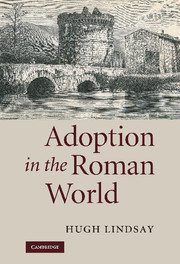Book contents
- Frontmatter
- Contents
- List of figures
- Preface
- List of abbreviations
- Introduction
- 1 Adoption, kinship and the family: cross-cultural perspectives
- 2 Kinship in Greece and Rome
- 3 Greek adoptions: comparisons and possible influences on the Roman world
- 4 Procedural aspects of Roman adoption
- 5 The testamentary adoption
- 6 Roman nomenclature after adoption
- 7 Adoption and inheritance
- 8 Roman freedmen and their families: the use of adoption
- 9 Adoption in Plautus and Terence
- 10 Sallust and the adoption of Jugurtha
- 11 Adrogatio and adoptio from Republic to Empire
- 12 Testamentary adoptions – a review of some known cases
- 13 Political adoptions in the Republic
- 14 Clodius and his adoption
- 15 The adoption of Octavian
- 16 Political adoption in the early Empire at Rome, Pompeii and Ostia; the imperial family
- Conclusion
- Glossary
- References
- Index
6 - Roman nomenclature after adoption
Published online by Cambridge University Press: 25 January 2010
- Frontmatter
- Contents
- List of figures
- Preface
- List of abbreviations
- Introduction
- 1 Adoption, kinship and the family: cross-cultural perspectives
- 2 Kinship in Greece and Rome
- 3 Greek adoptions: comparisons and possible influences on the Roman world
- 4 Procedural aspects of Roman adoption
- 5 The testamentary adoption
- 6 Roman nomenclature after adoption
- 7 Adoption and inheritance
- 8 Roman freedmen and their families: the use of adoption
- 9 Adoption in Plautus and Terence
- 10 Sallust and the adoption of Jugurtha
- 11 Adrogatio and adoptio from Republic to Empire
- 12 Testamentary adoptions – a review of some known cases
- 13 Political adoptions in the Republic
- 14 Clodius and his adoption
- 15 The adoption of Octavian
- 16 Political adoption in the early Empire at Rome, Pompeii and Ostia; the imperial family
- Conclusion
- Glossary
- References
- Index
Summary
Once the procedures for an adoption had been completed, an adoptee was expected to employ the nomenclature of the adopter. An example of this has already been reviewed, where Cicero, in a letter congratulating Atticus on his testamentary adoption, heads his letter with the revised nomenclature: Q. Caecilius Q. f. Pomponianus Atticus (Att. 3.20, dated 6 October 58 bc). The lack of a tribal indication in the Ciceronian formula is noteworthy. Cornelius Nepos independently records that the adoption was testamentary (Nepos, Att. 5). It is uncertain whether Atticus actually employed this handle, since Cicero's mock formalism seems to be intended simply to congratulate Atticus on taking up his inheritance from Caecilius. Caecilius was a knight and had no cognomen (Doer [1937] 82). After this time Atticus' freedmen were Caecilii, and his daughter was known as Caecilia Attica (Salomies [1992] 8). Atticus may well have taken on the revised nomenclature. In the case of M. Gallius, who adopted Tiberius in his will, the condicio nominis ferendi proved unenforceable. Political factors were influential. In cases where an adoptio or adrogatio is known or surmised to have taken place, changes in nomenclature are often observable, but formal requirements are unknown, and the picture is far from complete. It is assumed that formal adoptions inter vivos resulted in a stronger compulsion to adjust nomenclature. Other uncertain issues include whether an adoptee on emancipation retained his adoptive nomenclature, as seems inherently probable.
- Type
- Chapter
- Information
- Adoption in the Roman World , pp. 87 - 96Publisher: Cambridge University PressPrint publication year: 2009



